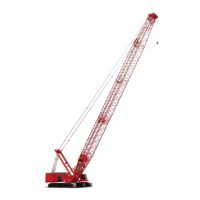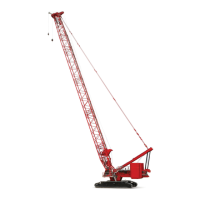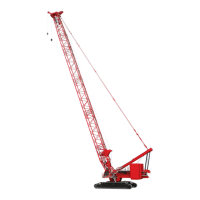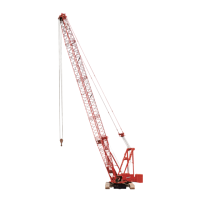Manitowoc Published 11-22-17, Control # 257-02 5-15
MLC300 SERVICE/MAINTENANCE MANUAL HOISTS
Drum 4 Pawl Control
Pawl Disengagement
When the drum 4 park switch is in the UN-PARK position, the
CCM-10 control module communicates the un-park
command to the IOLC31 control module via the controller
area network bus (CAN Bus).
The IOLC31 control module then sends 24 V
DC
to the pawl-
out solenoid on the pawl valve (13), energizing the solenoid.
The pawl valve shifts to the position that routes hydraulic
fluid from the pump 1 charge pump (6) to the rod side of the
drum pawl cylinder (15). The cylinder retracts, causing a cam
to rotate and disengage the pawl from the ratchet. For more
information, see Drum 4 Pawl on page 5-30
.
The drum 4 pawl limit switch signals the control system when
the pawl is disengaged by sending 0 V
DC
to the IOLC31
control module.
Pawl Engagement
When the drum 4 park switch is in the PARK position, the
CCM-10 control module communicates the park command
to the IOLC31 control module via the CAN Bus.
The IOLC31 control module then sends 24 V
DC
to the pawl-
in solenoid on the pawl solenoid valve (13), energizing the
solenoid. The pawl valve shifts to the position that routes
hydraulic fluid from the pump 1 charge pump (6) to the barrel
side of the drum pawl cylinder (15). The cylinder extends,
causing the cam to rotate in the opposite direction, allowing a
spring to engage the pawl with the ratchet. For more
information, see Drum 4 Pawl on page 5-30
.
The drum 4 pawl limit switch signals the control system when
the pawl is engaged by sending 24 V
DC
to the IOLC31
control module.
Drum 4 Hoisting Operation
The following conditions must be met to operate drum 4:
• Seat safety switch must be closed
• Drum 4 must be un-parked
When drum 4 joystick J1 is pulled back to raise the boom, the
CCM-10 control module sends an electrical signal to the
drum 4 system A control valve (8), and the CCMC11 control
module sends an electrical signal to the drum 4 system B
control valve (9). The control valves shift to a position that
routes hydraulic fluid to the raise side of the system.
At the same time, the CCM-10 control module sends a pulse-
width modulated (PWM) signal to the electronic
displacement controls (EDC) on pumps 3 and 4 (3 and 4).
The PWM signal is in proportion to the speed commanded by
the joystick. Increasing the PWM duty cycle increases the
pumps’ swashplate angle, which increases the hydraulic flow
from the pumps through the B ports of the system A and
system B control valves (8 and 9), then to the load-holding
valve (12) on the B side of the hydraulic motor (18).
In the holding valve, the hydraulic fluid flows through a check
valve, then to the B port on the motor, causing the motor to
attempt to turn the drum.
At the same time, the IOLC31 control module sends 24 V
DC
to the brake release solenoid valve (14), energizing the
solenoid. The brake valve shifts to a position that routes
hydraulic fluid from the pump 1 charge pump (6) to the brake
defeat valve (22). Hydraulic pressure created by the
pressure-reducing valve (23) on the A side of the motor
shifts the brake defeat valve (22). This allows the hydraulic
fluid from the brake release solenoid valve to flow to the
drum brake (17), releasing the brake.
As the motor starts to rotate, hydraulic pressure on the A
side of the motor opens the sequence valve (25), allowing
return hydraulic fluid to flow back to the tank via the drum 4
system A and system B control valves. This allows the drum
to turn in the direction that raises the boom.
The CCM-10 control module then sends a signal to the
IOLC31 control module via the CAN Bus to ramp up the
PWM duty cycle to the drum 4 motor controller. Increasing
the PWM duty cycle decreases the swashplate angle in the
motor, which increases the motor flow until the rotational
speed is maximized based on the pump flow.
The following sensors provide feedback to the controllers:
• Drum 4 Motor Speed Sensor
• Pump 3 Pressure Transducer
(pump 3 system B psi)
• Pump 4 Pressure Transducer
(pump 4 system A psi)
• Drum 4 Motor Pressure Transducer
(drum 4 motor psi)
• Drum 4 System A Pressure Transducer
(system A manifold psi)
• Drum 4 System B Pressure Transducer
(system B manifold psi)
The control system uses this feedback to adjust the pump
and motor flow to maintain the speeds commanded by drum
4 joystick J1.

